Burial
at Ornans was the focus of attention and criticism at the Paris Salon of
1850-1. One of Courbet's first Realist paintings, it treated an ordinary event
on the vast scale usually confined to 'history painting'.
Its
autobiographical content is typical of Courbet's work. The Meeting commemorates
the artist's first visit to his patron Alfred Bruyas, while The Winnowers shows
his sisters sifting corn at the family I farm. In The Painter's Studio, Courbet
himself occupies the centre of a vast allegorical composition.
Young
Ladies on the Banks of the Seine shows a lazy Sunday afternoon in Paris. It
provoked another scandal: one of the girls is dressed only in her underwear.
The Sleepers is even more risqué, but it was a private commission, and caused
no public outcry.
The
Trellis shows a less controversial response to the natural world, as does
Cliffs at Etretat, where the large scale and fresh approach create a powerful
impression of the raw grandeur of nature.
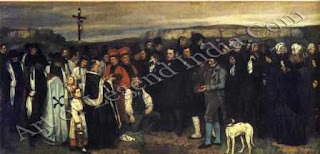 This
huge painting contains nearly 60 life-size figures, the townsfolk of Ornans,
gathered together for a funeral with male and female mourners separated
according to Catholic custom.
This
huge painting contains nearly 60 life-size figures, the townsfolk of Ornans,
gathered together for a funeral with male and female mourners separated
according to Catholic custom.
It
caused a tumult at the Salon. By painting on such a vast scale, Courbet turned
an everyday incident into a historic event. It is this monumental treatment of
contemporary daily life which makes this work one of Courbet's major Realist
paintings.
City-dwelling
observers saw it a 'glorification of vulgarity', and were threatened by the
uncomfortably life-like portrayal of a rural community: these were no homely
peasants, but real individuals with a complex class structure of their own The
painting is steeped in Courbet's own experience: it shows his family, friends,
local dignitaries and country people, and is set in the newly-consecrated
cemetery on a hill outside his home town.
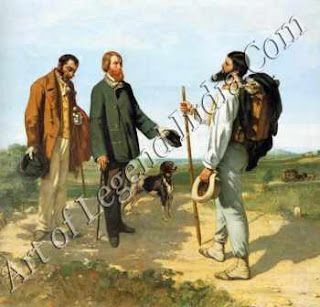
This painting Commemorates
Courbet`s arrival outside Montpellier in May 1354 on the occasion of his first
visit to the home of his patron Alfred Bruyas. It depicts a specific moment,
‘but the frozen gestures of the characters seem to have great significance. The
painting is almost an emblematic of the social relationships between the three
men. His “head held high, the artist meets his patron as an equal (perhaps as a
superior), while Bruyas’ servant stand by with his head been in deference and
humility. Indeed, one critic even described it as ‘Fortune bowing to Genius’.
The composition is derived from a popular print of the Wandering law, the
19th-century personification of the ‘outside of with whom Courbet liked to
identify himself.
.jpg)
The
major inspirations for Courbet’s art were the activities and customs of the
people he knew in his remote, rural homeland. In this striking image he shows
the working life of the women at Ornans. The strapping robust young woman
sifting grain has her back turned to the viewer, but she has been identified as
Zoe Courbet, the artist's sister. The other figures in the bolting-room may be
his youngest sister Juliette and his son Desire
Courbet who would have been about six years old when
the picture was painted. Although the artist has paid his usual attention to
the physical objects in the scene, the
derived from Japanese prints.
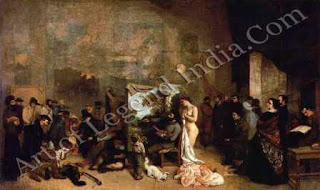
Courbet's subtitle
suggests that this painting sums up his artistic life from 1848 and 1855 the
years between the Revolutions mid the World Exhibition for which the painting
was intended. He calls it a 'real allegory a seeming contradiction in terms,
and one which indicates the complex nature of Courbet's art. For though his
paintings are called, 'Realist' they are often symbolic in content.
Courbet described the
'allegory' in a letter to his friend Champfleury, stating that the figures on
the left were those who 'live on death', while those on the right 'live on
life'. Champfleury is portrayed in this right-hand group, along with other
friends such as Proudhon and Baudelaire. Courbet, of course, occupies centre
stage.
While the figures on the
right are recognizable portraits of Courbet's colleagues, those on the left
whom the artist originally described as 'types' have only recently been given
individual identifications by the art historian Helene Toussaint. They include
a disguised portrait of the Emperor Napoleon III and various ex-Republican
turncoats, along with European freedom fighters, whom Napoleon and his ministers
were supporting perhaps sun ply to consolidate their power. The selection
committee of the World Exhibition did not recognize any such subversive message
in the painting, but they rejected it even so. It became the centre-piece of
Courbet's one-man show, the 'Pavilion of Realism'.

Begun in Ornans in 1856
and finished in Paris in time for the 1857 Salon, this painting of two young
women resting in the shade after a Sunday walk along the river shocked polite
Parisian society. While the girl in the background leans against a tree-trunk,
resting her chin in her lace-mittened hand, her friend has stripped off her
dress and sprawled out on the grass: she lies on the warm riverbank in her
chemise, corset and petticoats. Her eyes are half-closed in a suggestive
sideways gaze which implies the presence of an observer presumably a male.
Proudhon interpreted the painting as a comment on the loose morals of 'kept
women', but it seems more likely that Courbet simply delighted in the lazy
sensuousness of the weekend scene, and the delicate textures of the girls'
fashionable clothes.
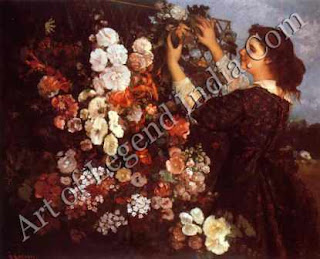
In 1862 Courbet began a
year-long visit to his friend Etienne Baudry at his chateau near Saintes in
France. Perhaps inspired by his friend's interest in botany, he painted a great
number of flower pictures during his stay. This is one of the most delightful
examples. Divided into two distinct sections, it shows a gorgeous display of
blooms being tended by a young woman, whose floral-print dress echoes the
flowers on the trellis. It recalls the symbolic flower paintings of the 17th
century Dutch Masters which glorified love and youth. Grouped together on the
trellis are flowers which bloom in spring, summer and autumn symbolizing the
stages of life and love? But Courbet's typical shallow picture space has left
little room for the girl herself; with her darkly outlined face, she appears
like a cut-out.
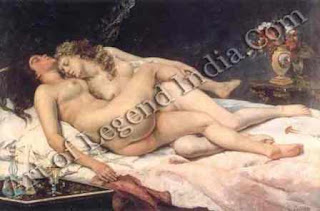
Courbet painted this sensuous
picture of lesbian love for Kahlil Bey, a wealthy Turk with an extravagant
taste for erotica. Whistler's mistress Jo Heffernan modelled for one of the
lovers, whose lost innocence is symbolized by the broken string of pearls.
The dramatic shoreline
at Etretat in Normandy attracted painters throughout the 19th century. Courbet
painted this magnificent, delicately balanced composition during the summer of
1869, but dated it 70'.
Writer – Marshall
Cavendish
 This
huge painting contains nearly 60 life-size figures, the townsfolk of Ornans,
gathered together for a funeral with male and female mourners separated
according to Catholic custom.
This
huge painting contains nearly 60 life-size figures, the townsfolk of Ornans,
gathered together for a funeral with male and female mourners separated
according to Catholic custom. .jpg) The
major inspirations for Courbet’s art were the activities and customs of the
people he knew in his remote, rural homeland. In this striking image he shows
the working life of the women at Ornans. The strapping robust young woman
sifting grain has her back turned to the viewer, but she has been identified as
Zoe Courbet, the artist's sister. The other figures in the bolting-room may be
his youngest sister Juliette and his son Desire
Courbet who would have been about six years old when
the picture was painted. Although the artist has paid his usual attention to
the physical objects in the scene, the
derived from Japanese prints.
The
major inspirations for Courbet’s art were the activities and customs of the
people he knew in his remote, rural homeland. In this striking image he shows
the working life of the women at Ornans. The strapping robust young woman
sifting grain has her back turned to the viewer, but she has been identified as
Zoe Courbet, the artist's sister. The other figures in the bolting-room may be
his youngest sister Juliette and his son Desire
Courbet who would have been about six years old when
the picture was painted. Although the artist has paid his usual attention to
the physical objects in the scene, the
derived from Japanese prints.





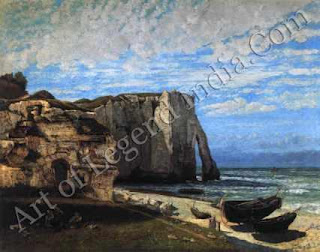










0 Response to "French Great Artist - Gustave Courbet Painting Gallery"
Post a Comment